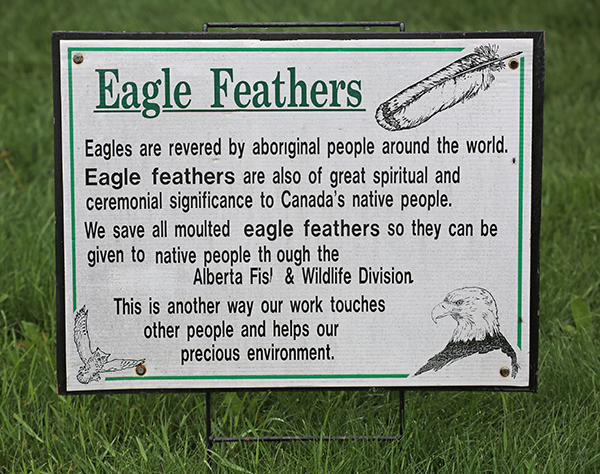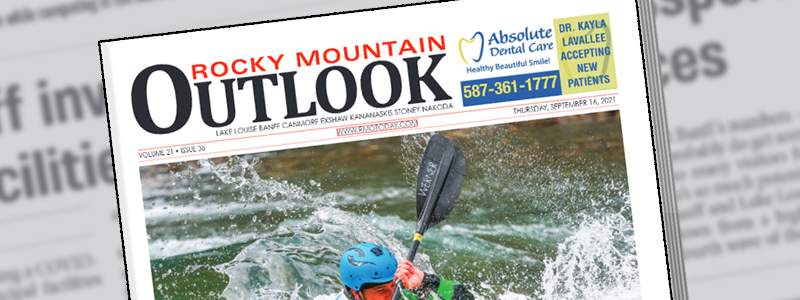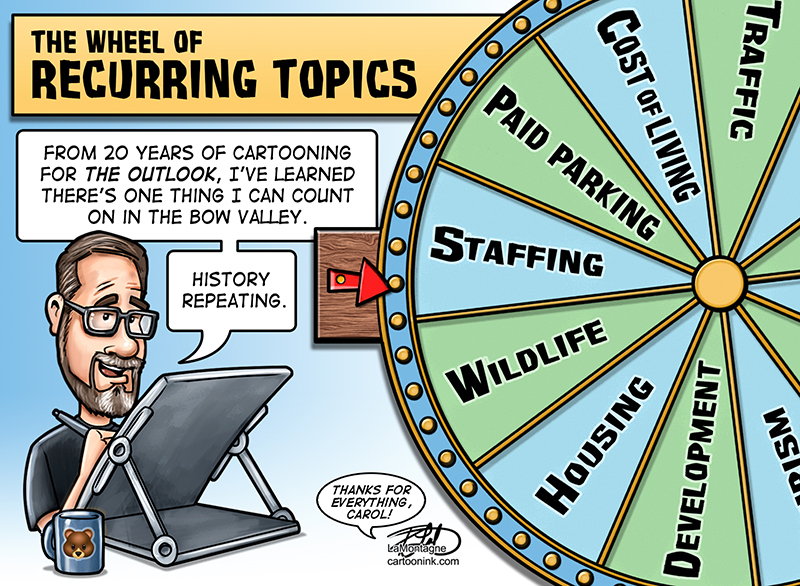
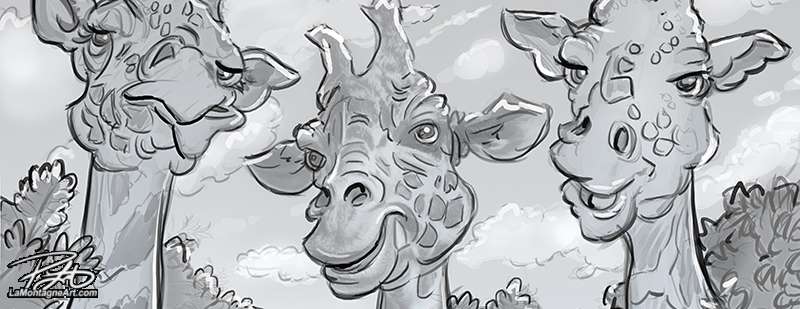 In 2008, I hosted the Canadian Editorial Cartoonists Conference in Banff. Several industry veterans who attended came up in a culture where busy unionized daily newspapers hired editorial cartoonists for impressive salaries, benefits, and pensions. I began my career at the end of all that.
In 2008, I hosted the Canadian Editorial Cartoonists Conference in Banff. Several industry veterans who attended came up in a culture where busy unionized daily newspapers hired editorial cartoonists for impressive salaries, benefits, and pensions. I began my career at the end of all that.
I put a lot of work into the conference and preparing a Photoshop drawing class, trying to impress and curry favour with the more established cartoonists in this exclusive club. But, unfortunately, I realized too late that nobody cared. They were simply looking for an excuse to visit Banff, hang out and talk shop. It was about nostalgia, politics, and competitors fishing for information.
I wanted to improve my skills and artwork and learn how to adapt to a struggling industry, but many of them were focused on avoiding having to change. In fact, in the wrap-up, one of the more senior cartoonists loudly promised there wouldn’t be any Photoshop drawing classes at the next conference.
Clearly, I didn’t belong in this group.
In 2009, I attended another conference, the National Association of Photoshop Professionals in Las Vegas. I had been a member of this supportive online community for several years. Critiques were constructive, questions were answered with enthusiasm, and I learned more from that association than any before or since.
Fresh off that first Photoshop World conference, inspired to try something new, I painted a funny looking grizzly bear, my first whimsical wildlife portrait.
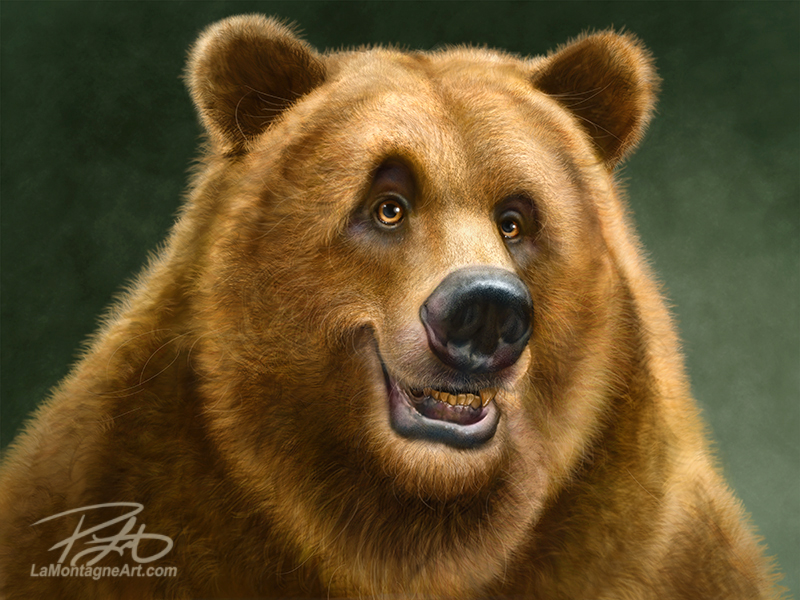 I went to that conference five times between 2009 and 2014. In 2010 and 2014, I won multiple Guru Awards for my animal paintings, including two Best in Show awards. The classes and instructors, the community of friends and colleagues, it was time and money well spent.
I went to that conference five times between 2009 and 2014. In 2010 and 2014, I won multiple Guru Awards for my animal paintings, including two Best in Show awards. The classes and instructors, the community of friends and colleagues, it was time and money well spent.
At Photoshop World, I made valuable business connections. For a long time after, I had a welcome working relationship with Wacom, the company that makes the drawing tablets and displays I’ve used for the past 25 years. I recorded two training DVDs for PhotoshopCAFE, and NAPP helped me form a strong foundation for my creative skills.
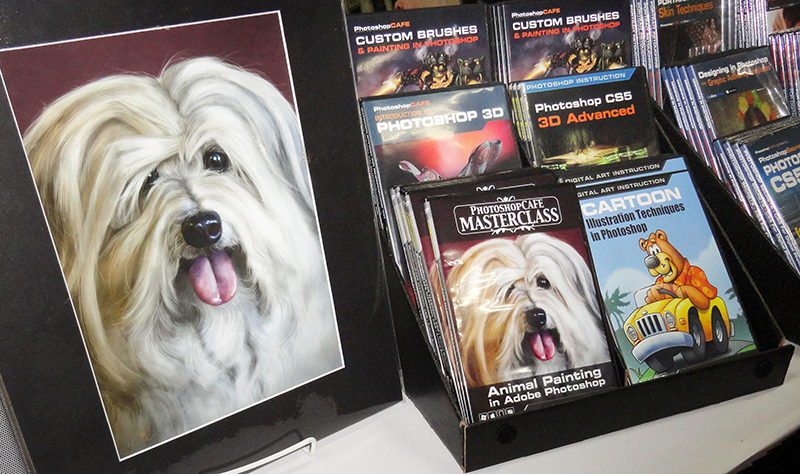 Eventually, social media killed the forum, and the organization rebranded. As a result, NAPP no longer exists, and the Photoshop World conference is a ghost of its former self.
Eventually, social media killed the forum, and the organization rebranded. As a result, NAPP no longer exists, and the Photoshop World conference is a ghost of its former self.
Time spent pining for the way things used to be is a waste. Adaptation is the most useful skill a self-employed artist can have.
While licensing and retailers are essential for my business, those customers each have their own ideas of what they want from my work. One retailer wants more bears; another wants more wolves. One agency wants me to follow seasonal trends; another client wants more realistic animals. Some products sell better with brighter, more colourful elements, and some without a background. Some items work better with a vertical layout, others horizontal.
Most artists have heard they should find their niche, the work that makes them unique and different from everybody else. It’s the key to survival in a crowd where a lot of art looks the same. But if you work hard and are lucky enough to discover the work that defines you, the next piece of advice you hear is that you need to make it appeal to everyone all the time.
Well, which is it?
How do you create work you enjoy enough to keep doing it year after year and continue to make it pay? How do you serve your customers and clients and allow their input and direction without changing your work so much that it’s no longer yours? Is it artwork or factory work?
When it becomes a grind or just about pumping out more images, it can take all the joy out of it. Lately, finishing some paintings has brought the same sense of accomplishment I get from cleaning the house. That’s a telltale sign of burnout. I’ve been here before, more than once. It’s a common experience with anyone who creates anything, especially if it’s their job, a warning that something’s got to give.
I know how to paint a single animal. I’ve put almost fifteen years into it. Each takes hours to paint, and the work I’m doing now is better than I’ve ever done, but it’s still the same style and (shudder) formula. It’s not as challenging or fulfilling as it used to be.
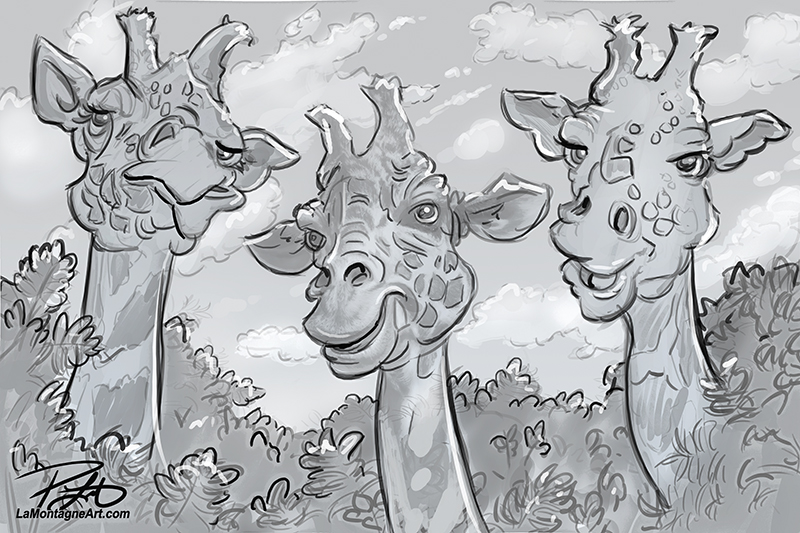 I’ve taken a new approach with the trio of giraffes, already titled “Long Neck Buds.” I don’t know if it will work the way I imagine it, but if it does, it will be the first of several I plan to paint this way.
I’ve taken a new approach with the trio of giraffes, already titled “Long Neck Buds.” I don’t know if it will work the way I imagine it, but if it does, it will be the first of several I plan to paint this way.
This latest individual giraffe isn’t quite a finished piece, but it’s close. It will also be the middle giraffe in the painting based on the group sketch above. With the simple background, it’s a solid painting on its own. I’ll paint the other two individually, like this first one, with my usual high detail, then I’ll place them all together. Finally, I’ll paint the sky, clouds and leaves around them.
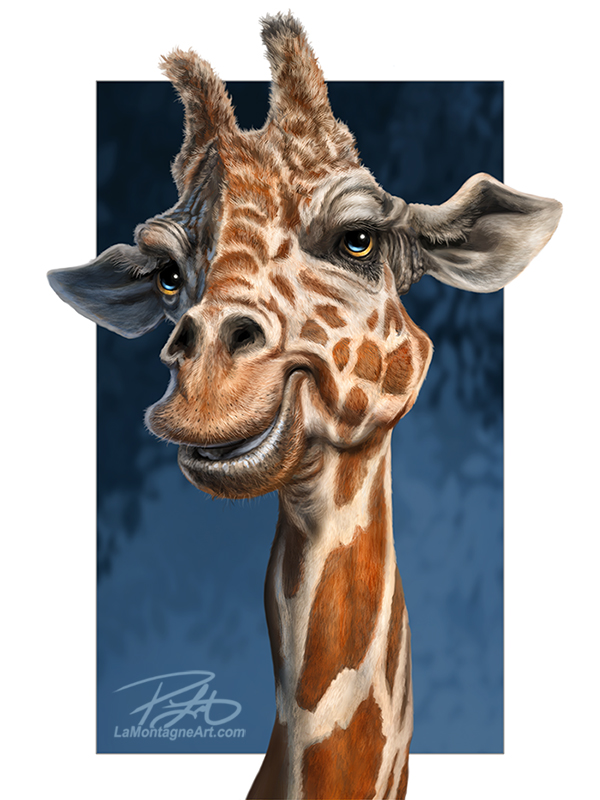 I’m a commercial artist, it’s how I make my living. I don’t pretend otherwise. But this is also supposed to be fun. I want to paint more detailed and elaborate images I’ll enjoy while also leaving options open for clients and licenses with different needs.
I’m a commercial artist, it’s how I make my living. I don’t pretend otherwise. But this is also supposed to be fun. I want to paint more detailed and elaborate images I’ll enjoy while also leaving options open for clients and licenses with different needs.
I want to create more paintings this way—a troop of meerkats, several burrowing owls, and a waddle of penguins. I could paint different species in an image. However, with each critter as detailed as my usual work, these will take longer than a single painting, requiring a more substantial investment in each piece.
I get nervous when spending too much time on one painting, likely due to many years of drawing editorial cartoons. Twenty years ago, when almost nobody was publishing my work, I would spend many hours nitpicking a cartoon, trying to get a caricature right or fussing with perspective. Shonna and I referred to these as Sistine Chapel cartoons. I had to train myself to say, “good enough.”
Most political cartoons have a short shelf life, so speed is essential. Get it done, get it out, and get started on the next one. My cartoon work pays monthly bills.
With a painting, however, the income can come anywhere from next week to next year. Pieces I painted ten years ago are still paying today. Paintings are an investment in future prints, products and licensing, income that often comes later.
This year, I’m making time to play and experiment.
I’ll share works in progress, sketches, and thoughts along the way, but fewer finished pieces. The ones I do complete will be bigger and hopefully worth waiting for. Of course, I expect I’ll still paint a single animal here and there if the mood strikes me.
11” X14” poster prints will come out only a couple of times a year rather than as I complete them. With higher shipping costs, I imagine that it won’t be a problem for collectors of my work to be able to order two or three new pieces at a time with one shipping cost.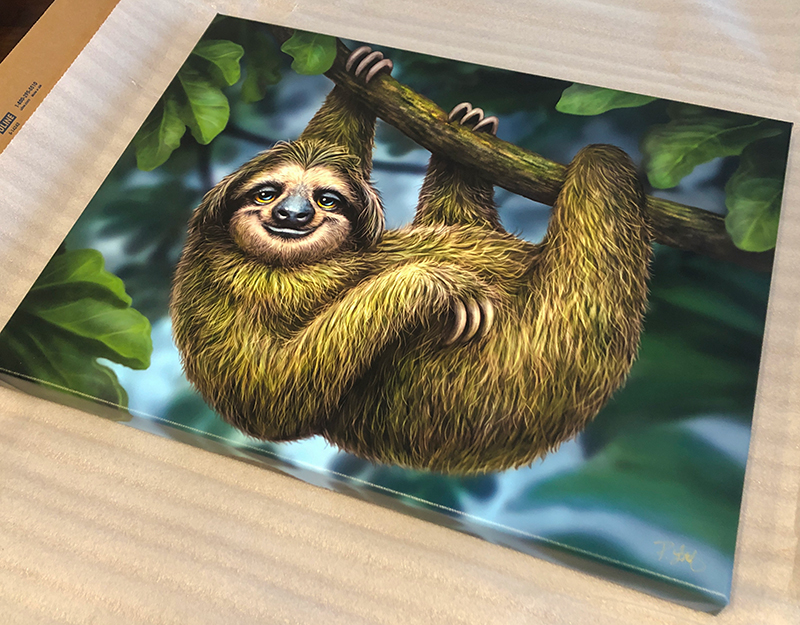 But I’ll still welcome custom metal and canvas special order prints. You can order those by email anytime. The above 18”x24” sloth on canvas and 20″x20” Blue Beak Raven on metal below are two custom orders that arrived this week.
But I’ll still welcome custom metal and canvas special order prints. You can order those by email anytime. The above 18”x24” sloth on canvas and 20″x20” Blue Beak Raven on metal below are two custom orders that arrived this week.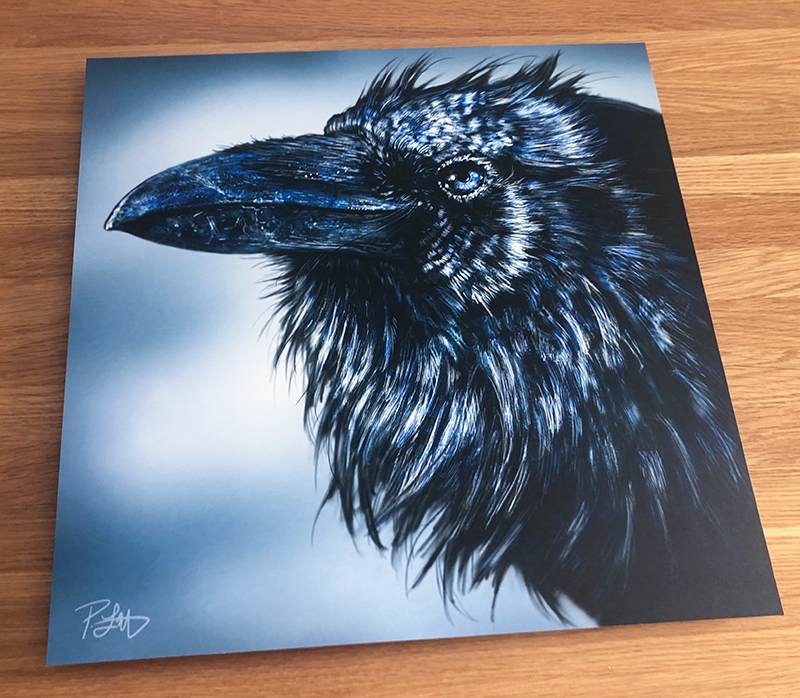 The puzzles I launched this year felt like a considerable risk, but I sold a lot of them and have received requests for more. I’m suddenly motivated to plan paintings that will work as prints, puzzles, stickers and more. I’m also exploring puzzle licensing opportunities.
The puzzles I launched this year felt like a considerable risk, but I sold a lot of them and have received requests for more. I’m suddenly motivated to plan paintings that will work as prints, puzzles, stickers and more. I’m also exploring puzzle licensing opportunities.
In the meantime, my collection of more than 100 paintings will continue to pay the bills with prints and licensing, as will drawing daily editorial cartoons, for as long as newspapers hang on.
I’m not having any fun. That needs to change.


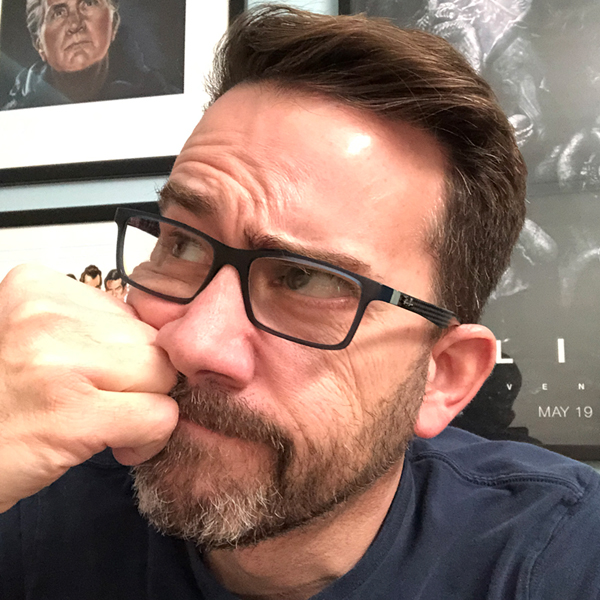
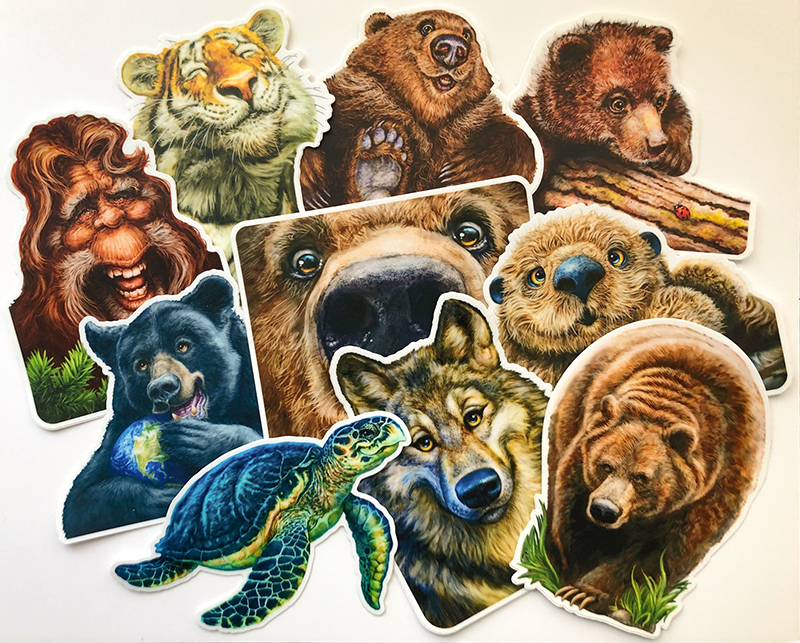
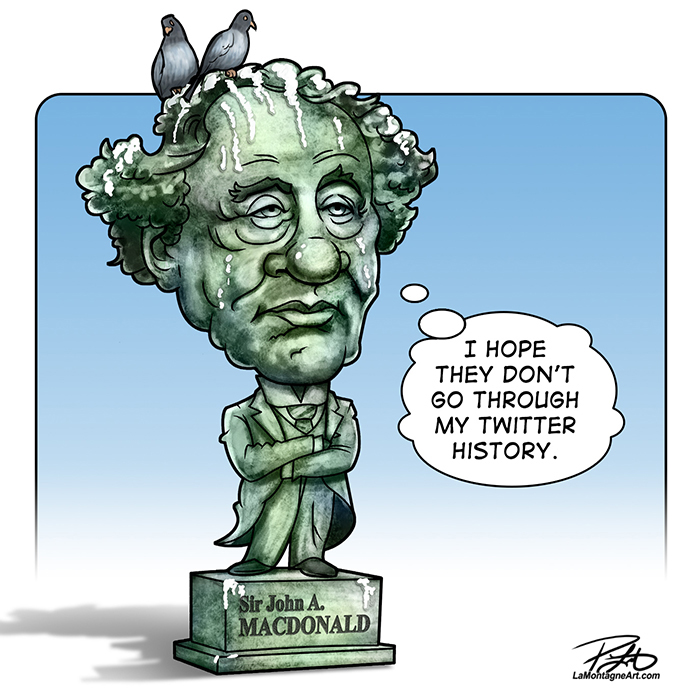
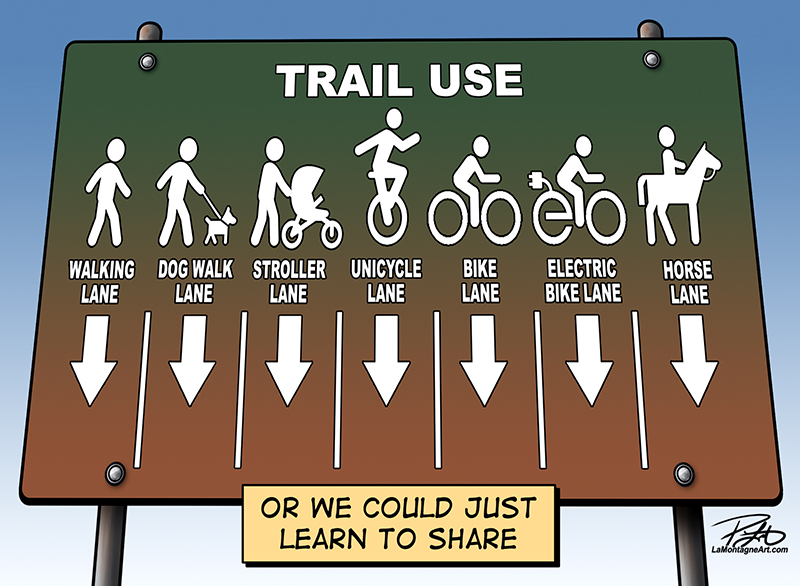
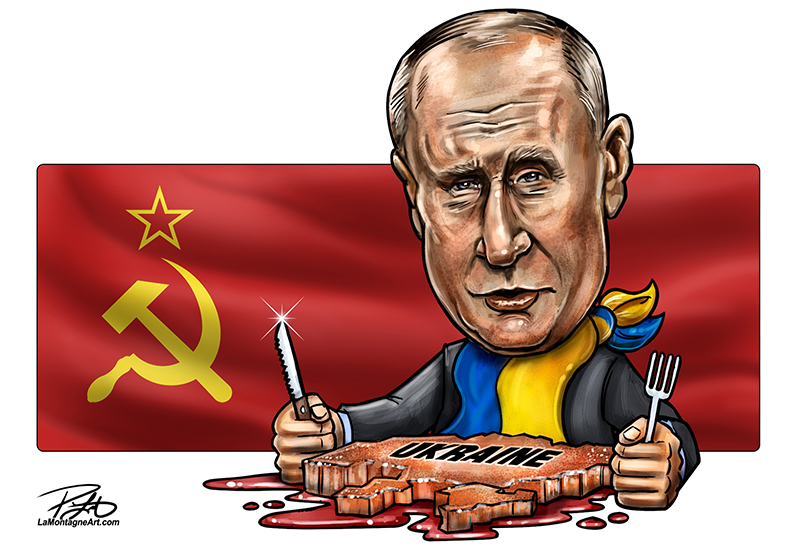
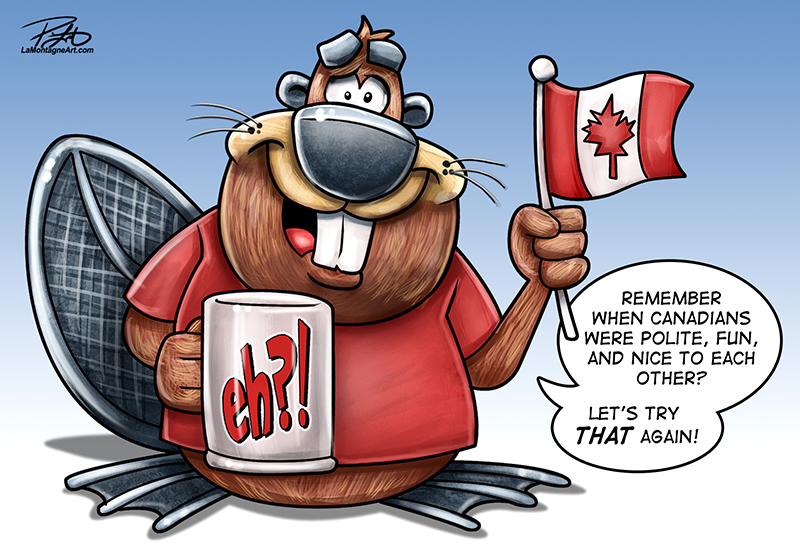
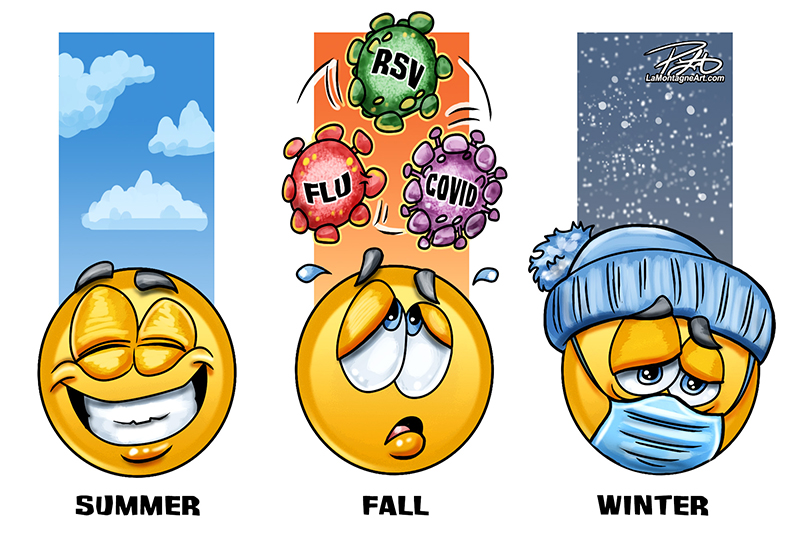

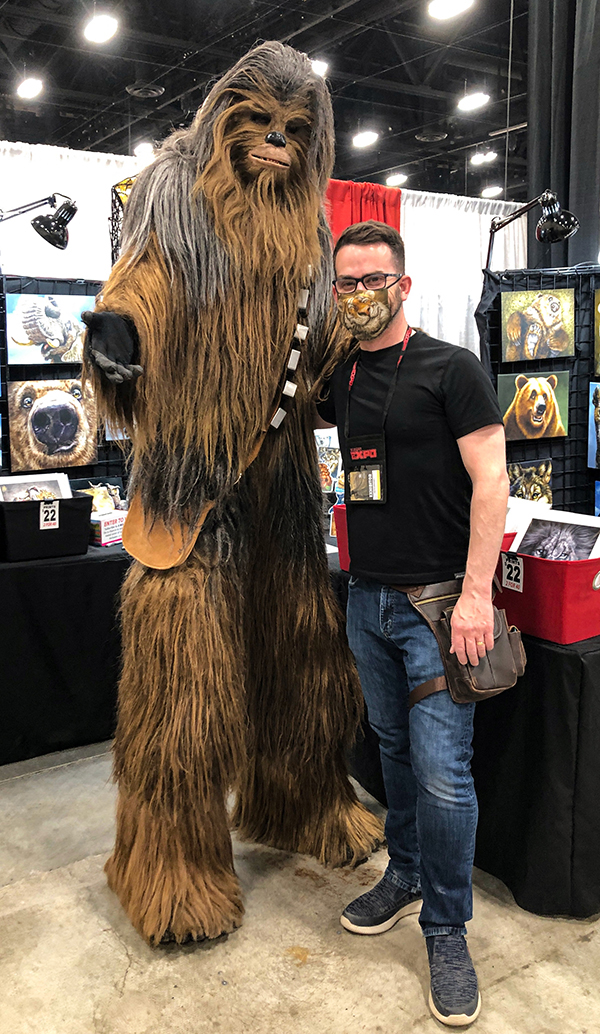
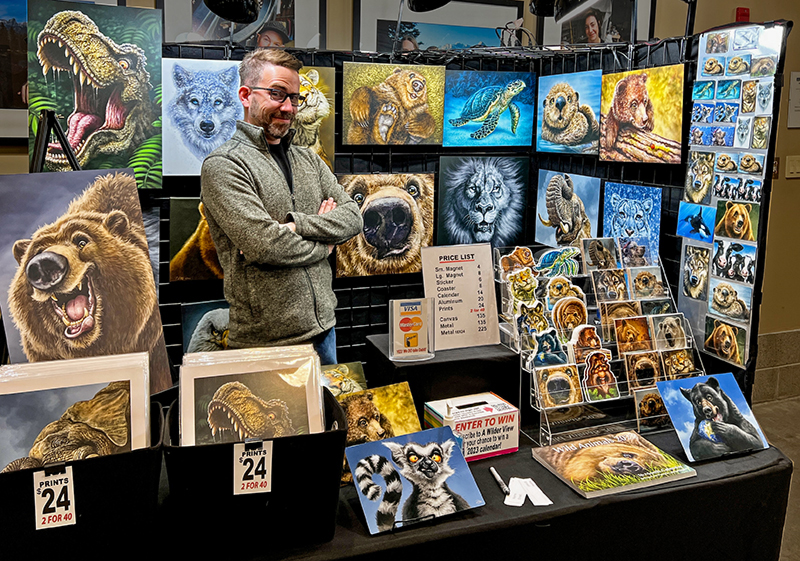 There were several Mountain Made Markets this year, with weekend events every month from May to December. Held indoors at the Canmore Civic Centre, it’s an easy setup close to home, so it’s worth my time.
There were several Mountain Made Markets this year, with weekend events every month from May to December. Held indoors at the Canmore Civic Centre, it’s an easy setup close to home, so it’s worth my time.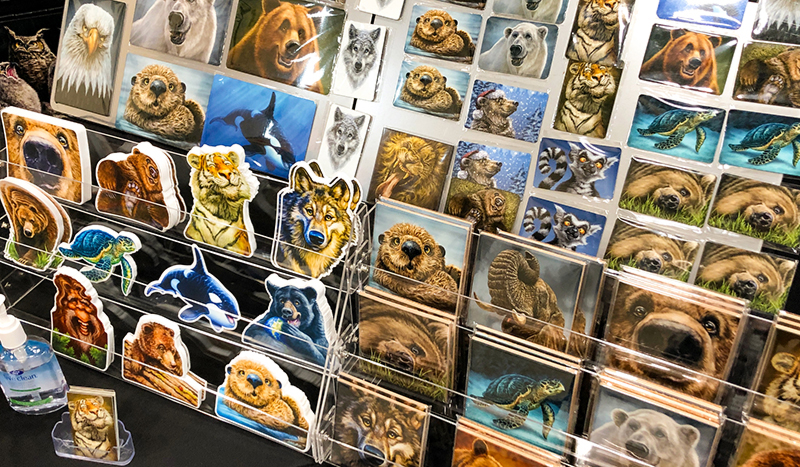 Licensing allows me to spend my time painting and still reach new markets and audiences. I signed a few new deals this year with
Licensing allows me to spend my time painting and still reach new markets and audiences. I signed a few new deals this year with 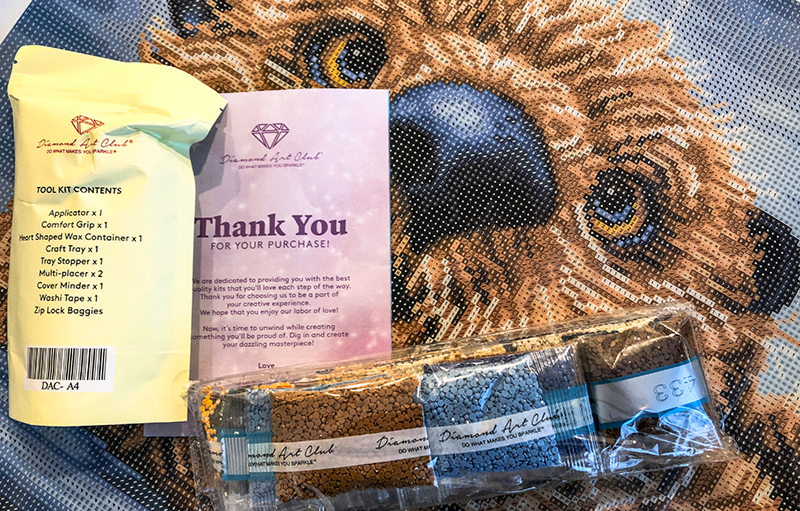
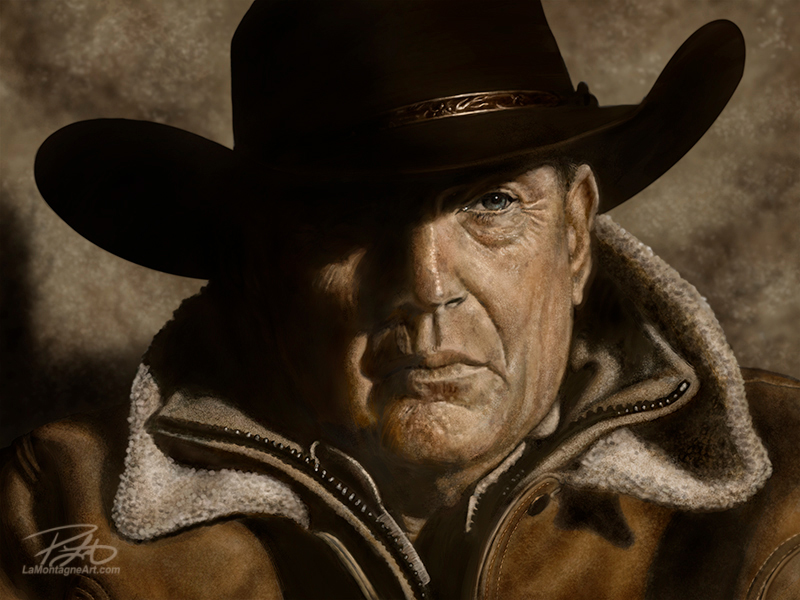
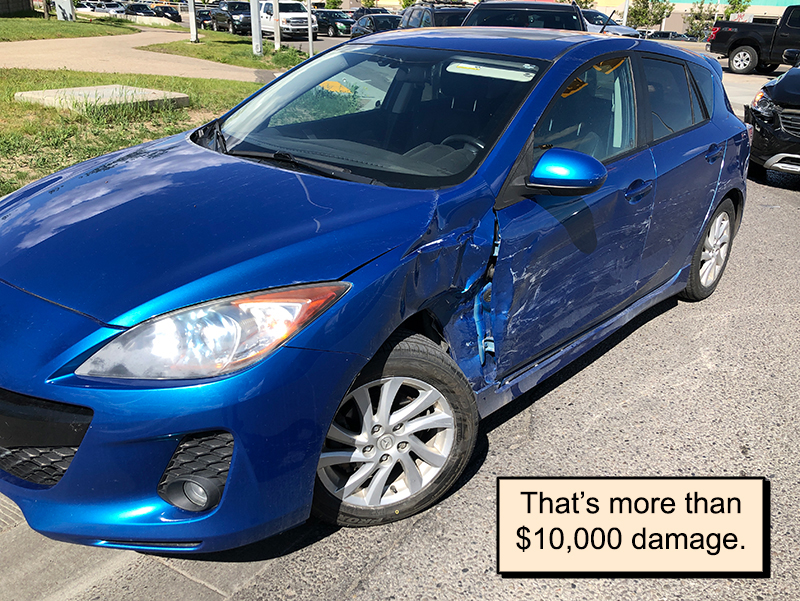

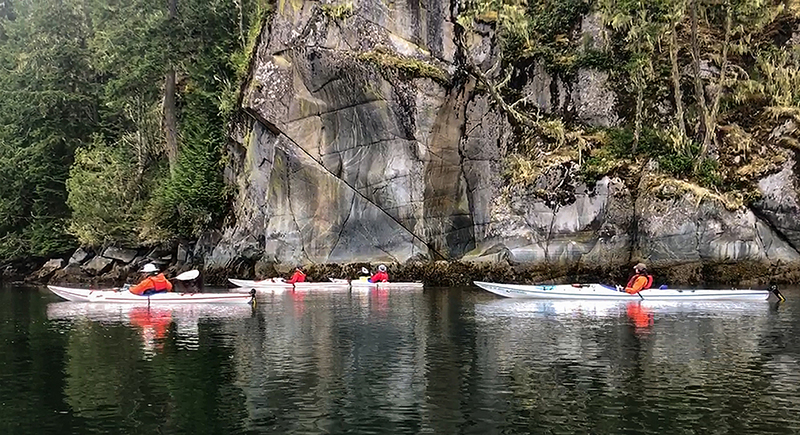
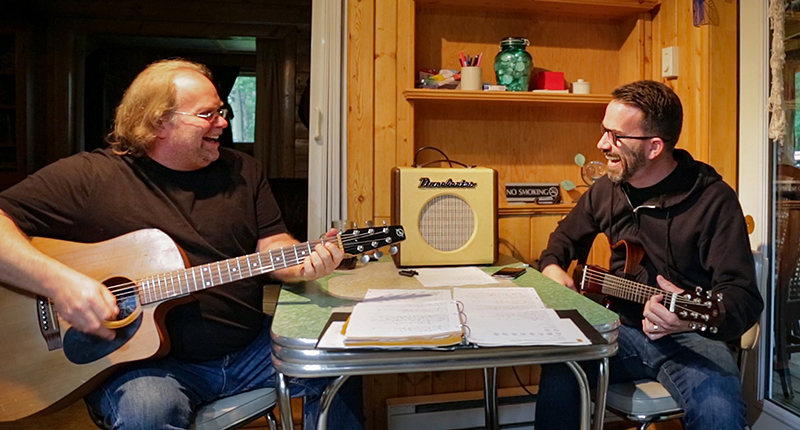

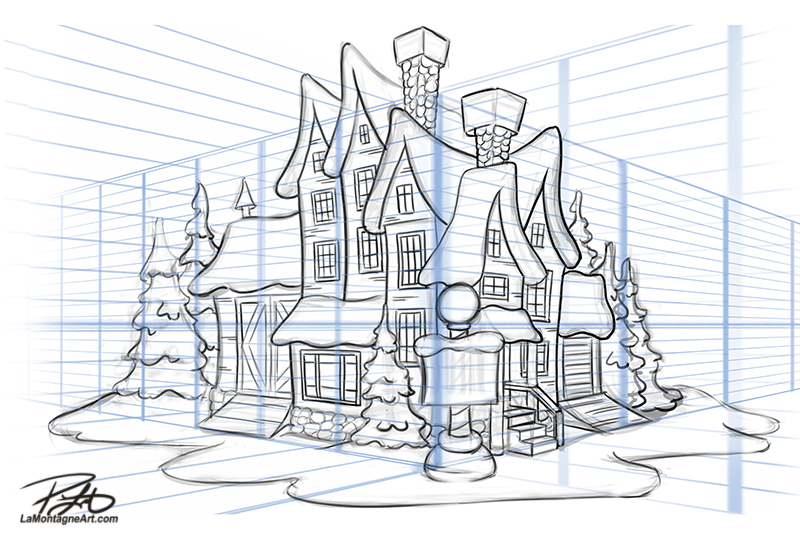
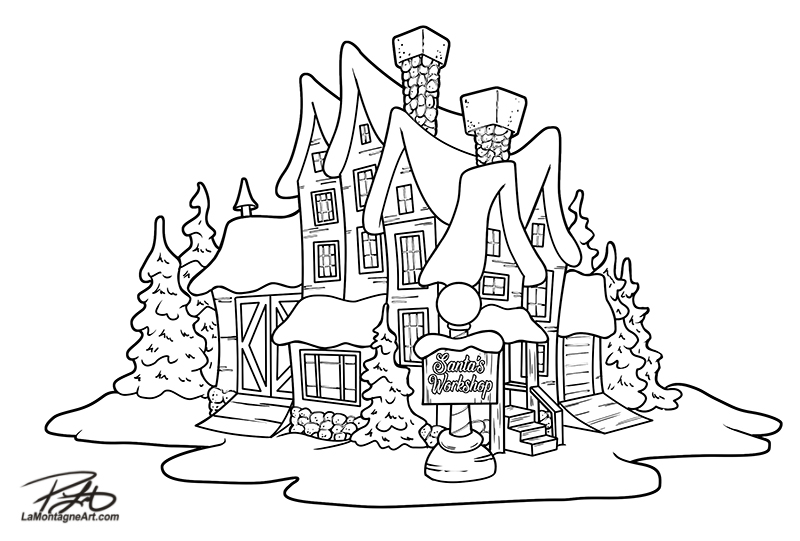 Then I’ll drop the opacity of the sketch layer, so it’s very faint and create cleaner black lines on the layer above. I call this an Ink layer, even though there’s no ink involved.
Then I’ll drop the opacity of the sketch layer, so it’s very faint and create cleaner black lines on the layer above. I call this an Ink layer, even though there’s no ink involved.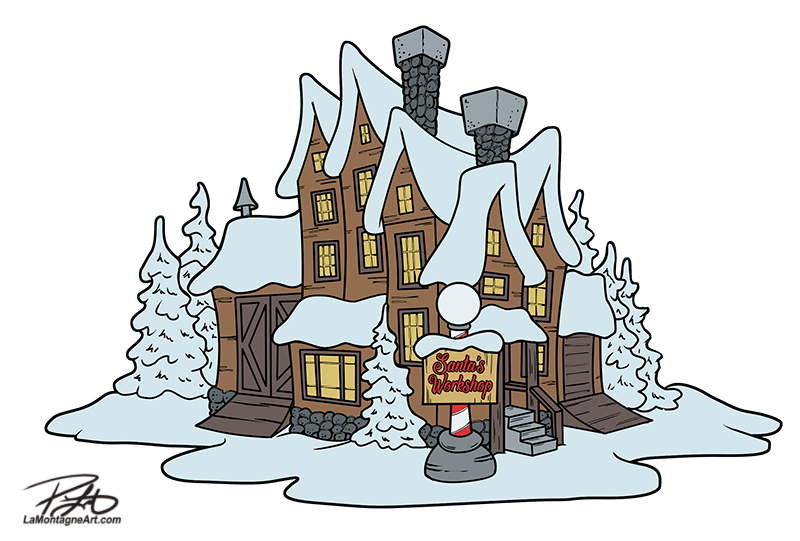 I’ll delete the sketch, create a new layer beneath the ink layer and fill in sections of flat colour on different layers. This helps me establish a base colour for separate pieces and select certain painting sections easily.
I’ll delete the sketch, create a new layer beneath the ink layer and fill in sections of flat colour on different layers. This helps me establish a base colour for separate pieces and select certain painting sections easily.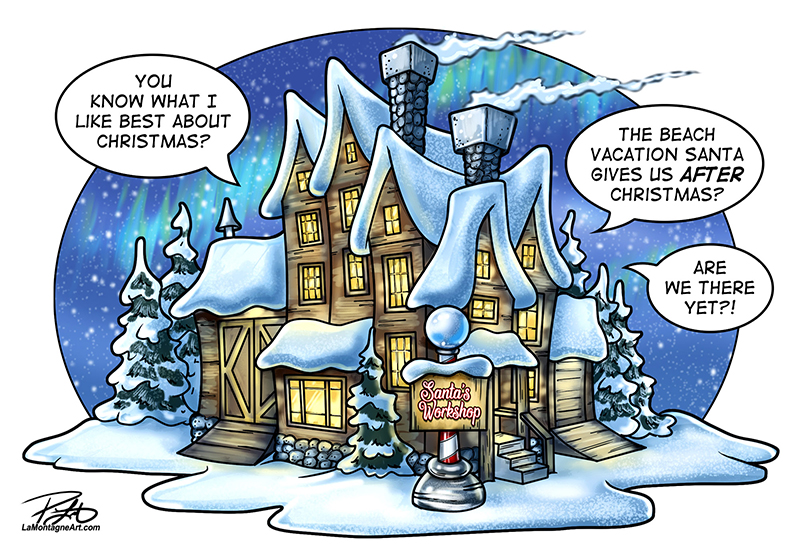 Finally, I’ll create a painted background, add talk bubbles, my text and signature, and save different formats to send to my newspaper clients across Canada.
Finally, I’ll create a painted background, add talk bubbles, my text and signature, and save different formats to send to my newspaper clients across Canada.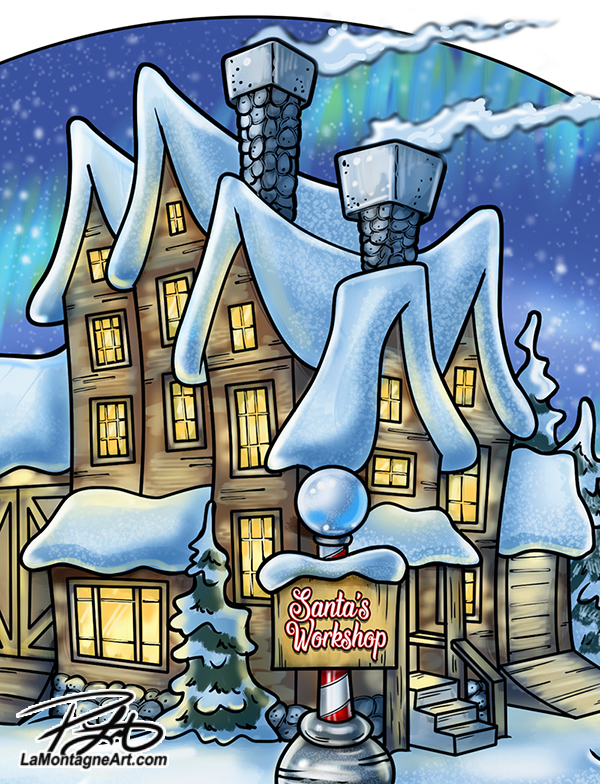 The painting process I use for my whimsical wildlife and portraits of people is more complicated because each painting takes many hours to complete and involves a lot of fine detail. But the tools are the same. Many artists have asked me about my painting brushes over the years, and they’re surprised that they’re not complicated. Just like in traditional art, it isn’t the brush; it’s the person wielding it.
The painting process I use for my whimsical wildlife and portraits of people is more complicated because each painting takes many hours to complete and involves a lot of fine detail. But the tools are the same. Many artists have asked me about my painting brushes over the years, and they’re surprised that they’re not complicated. Just like in traditional art, it isn’t the brush; it’s the person wielding it.

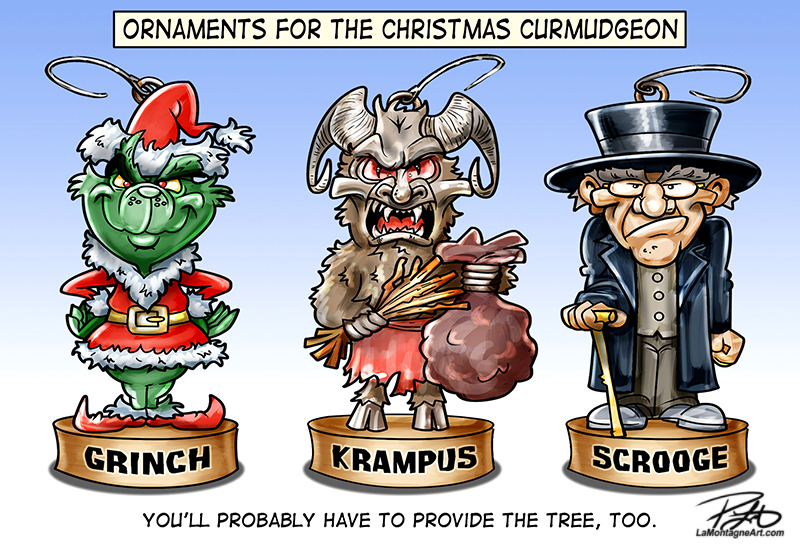 Near as I can tell, it was the seven years working in the tourism industry in Banff that exorcised the spirit of Christmas from this here cartoonist and painter of whimsical wildlife.
Near as I can tell, it was the seven years working in the tourism industry in Banff that exorcised the spirit of Christmas from this here cartoonist and painter of whimsical wildlife.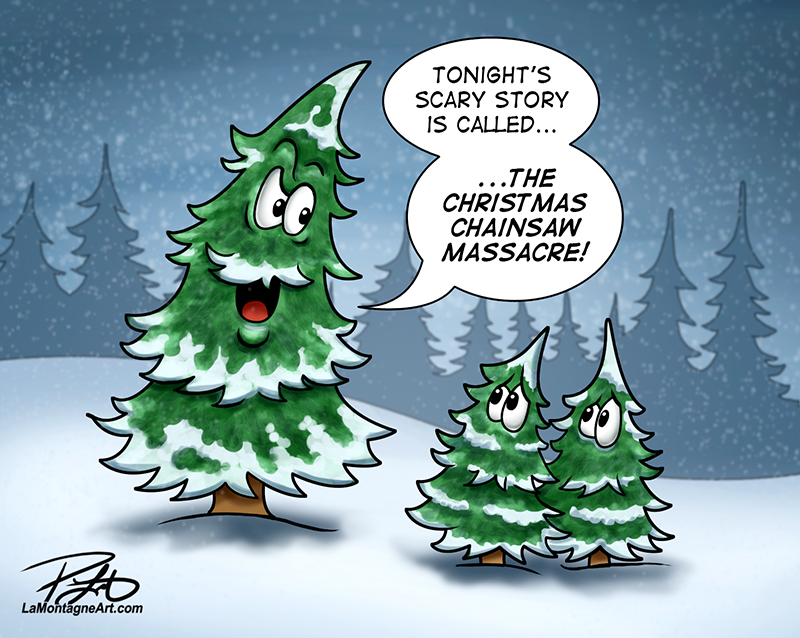 Shonna and I have not had a tree or decorations in more than twenty years. Aside from a few extra blankets on the couch, our home looks the same on December 25th as on July 25th. We don’t exchange gifts, and we don’t make a big meal.
Shonna and I have not had a tree or decorations in more than twenty years. Aside from a few extra blankets on the couch, our home looks the same on December 25th as on July 25th. We don’t exchange gifts, and we don’t make a big meal.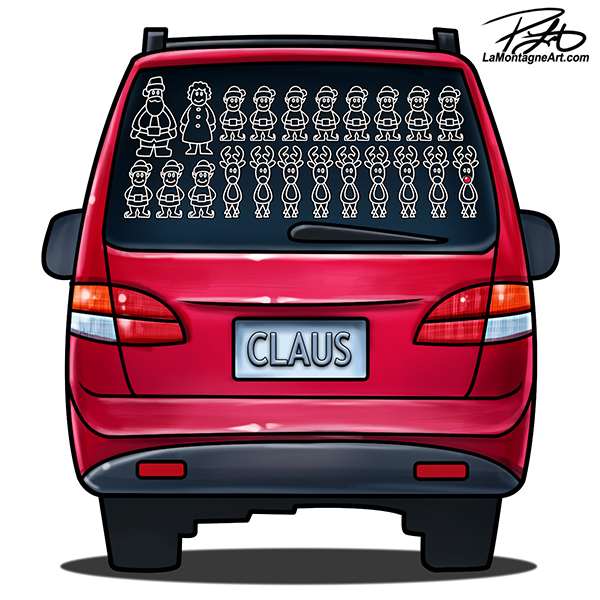 I welcomed the excuse not to travel. In the darkest month, with the best chance for the worst weather and most treacherous driving, while we’re all under peak stress, everybody hits the road at the same time. And if the highways close for a winter whiteout, and the RCMP tell you to stay home, well, that’s just too bad. Find a way; otherwise, you’ve ruined Christmas for everybody.
I welcomed the excuse not to travel. In the darkest month, with the best chance for the worst weather and most treacherous driving, while we’re all under peak stress, everybody hits the road at the same time. And if the highways close for a winter whiteout, and the RCMP tell you to stay home, well, that’s just too bad. Find a way; otherwise, you’ve ruined Christmas for everybody.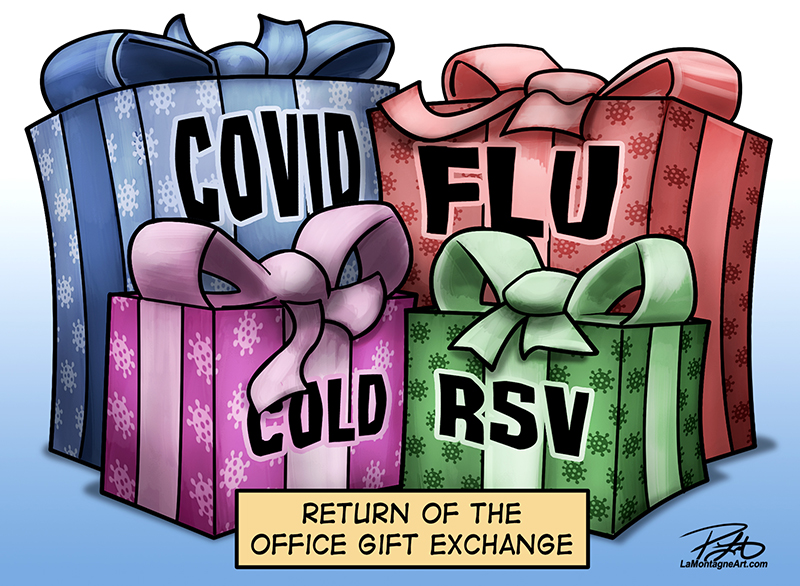 Even before the pandemic, ‘tis the season when we’re all contagious. So, we get together with as many people as possible, cram ourselves into crowded spaces, shake hands, hug and kiss and then eat a bunch of finger food.
Even before the pandemic, ‘tis the season when we’re all contagious. So, we get together with as many people as possible, cram ourselves into crowded spaces, shake hands, hug and kiss and then eat a bunch of finger food.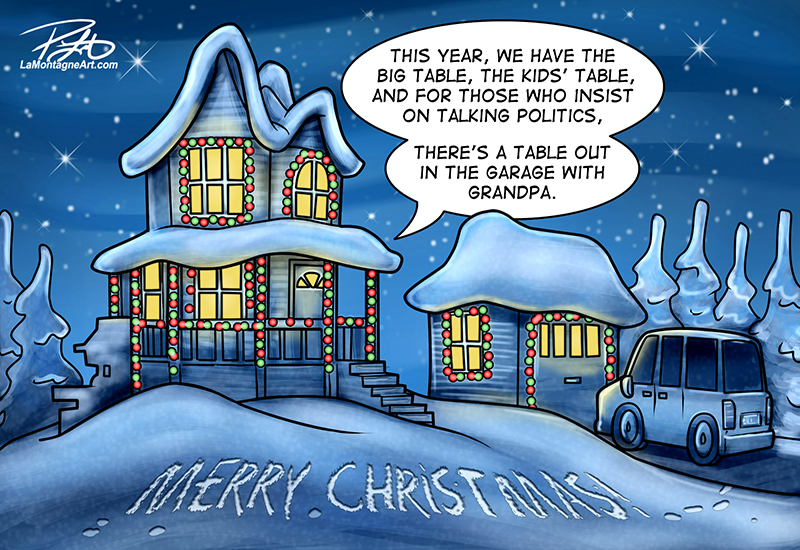 But here’s where it gets weird.
But here’s where it gets weird. True, there’s always a cynical tone to these cartoons, making fun of the season and my issues with it, but that’s a pillar of the editorial cartoonist profession all year long. I usually come up with far too many ideas this time of year, more than I can draw in December.
True, there’s always a cynical tone to these cartoons, making fun of the season and my issues with it, but that’s a pillar of the editorial cartoonist profession all year long. I usually come up with far too many ideas this time of year, more than I can draw in December.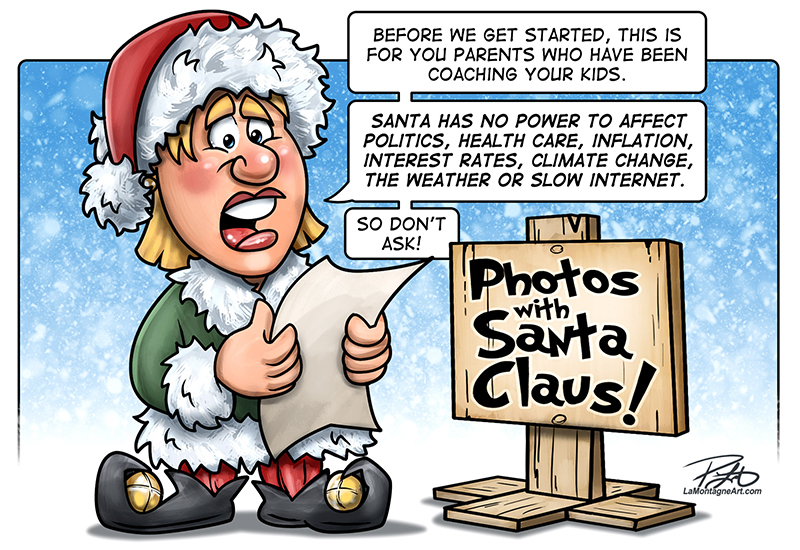
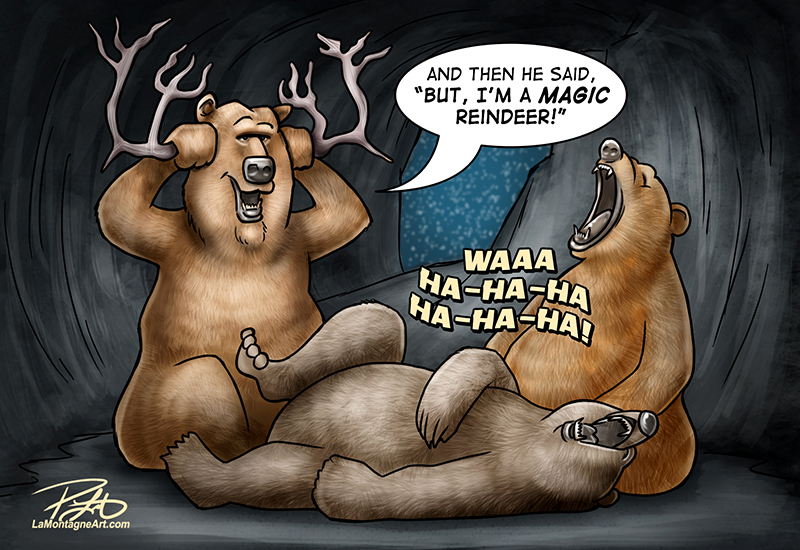
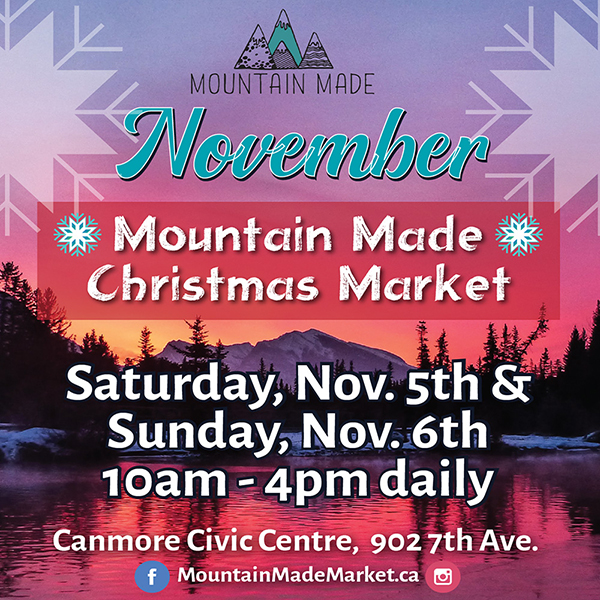
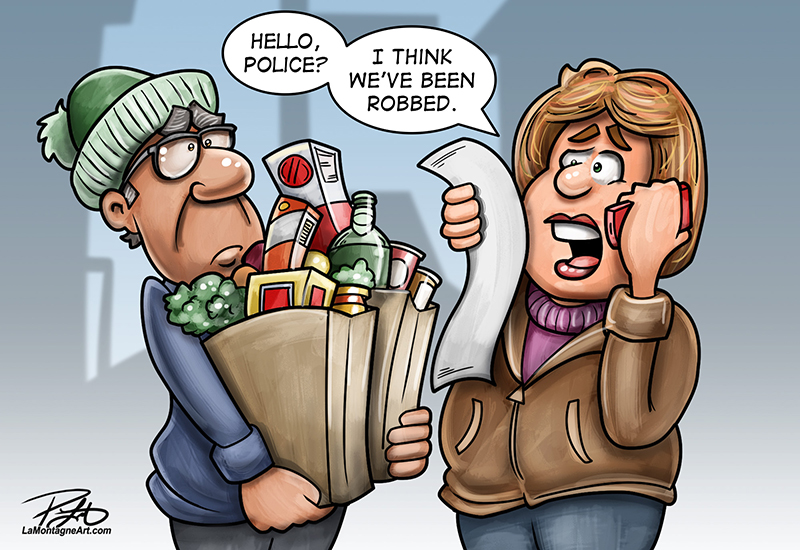 When a telecommunications provider, chain grocery store, or other large corporation that boasts record profits every quarter adds this fee, it is a money grab. These companies have been working hard for years to get people to use credit cards, and it’s included in their pricing.
When a telecommunications provider, chain grocery store, or other large corporation that boasts record profits every quarter adds this fee, it is a money grab. These companies have been working hard for years to get people to use credit cards, and it’s included in their pricing.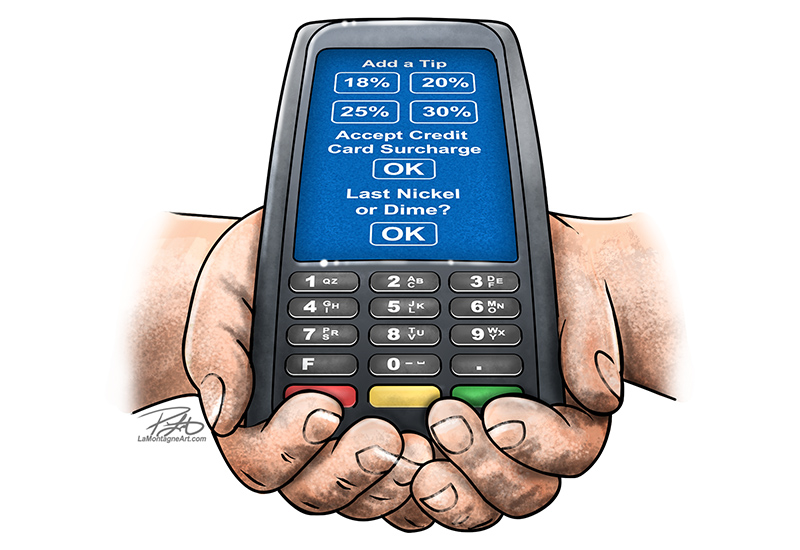 The best we can do is suggest somebody pay by e-transfer as there’s no cost to the consumer or vendor. Debit is also preferred as the transaction fee is significantly less. Or better yet, how about cash, if you even carry that around anymore?
The best we can do is suggest somebody pay by e-transfer as there’s no cost to the consumer or vendor. Debit is also preferred as the transaction fee is significantly less. Or better yet, how about cash, if you even carry that around anymore?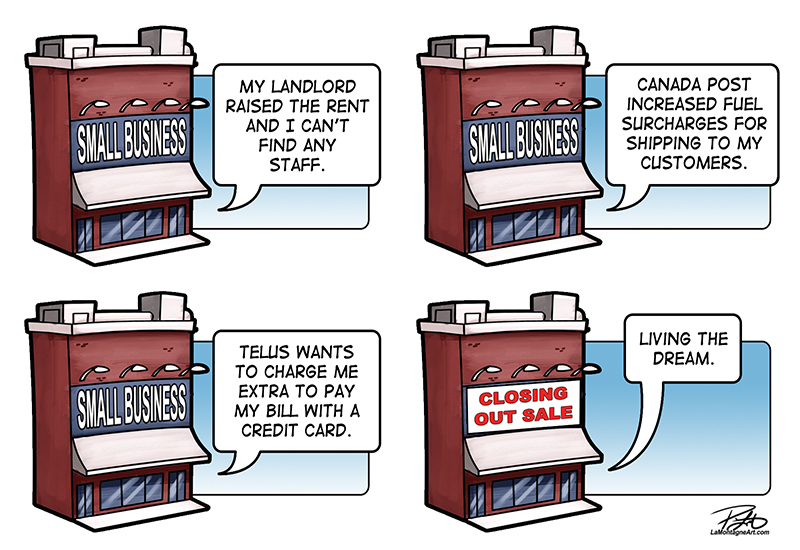 To expect a self-employed small business owner and independent artist to compete with Amazon’s pricing is ludicrous. The only reason they can do that is their sales volume gives them preferred credit card and shipping rates. Any company listing an item on Amazon accepts a much smaller profit margin per item to have a spot on the site.
To expect a self-employed small business owner and independent artist to compete with Amazon’s pricing is ludicrous. The only reason they can do that is their sales volume gives them preferred credit card and shipping rates. Any company listing an item on Amazon accepts a much smaller profit margin per item to have a spot on the site.
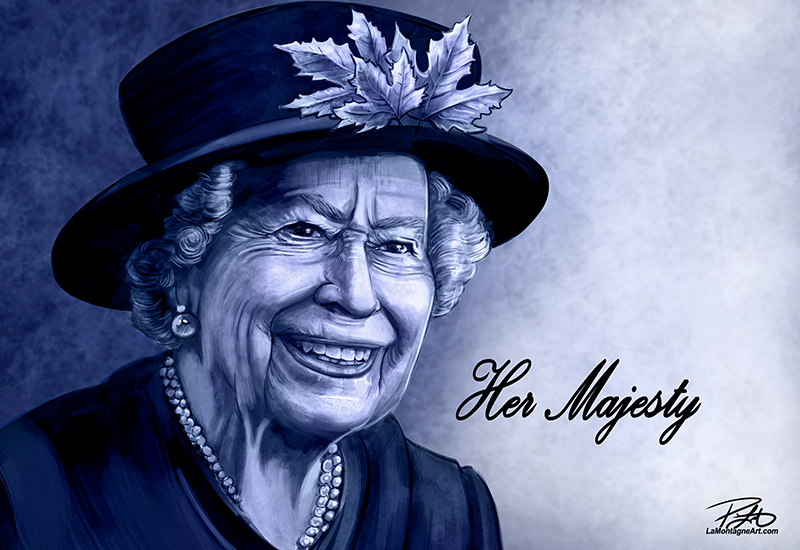 When she got COVID earlier in February, I drew this cartoon, just in case it was time. While it might seem morbid to some, I can assure you that every media outlet in the world has had content and plans laid out far in advance for her inevitable passing. Long before this year, the Queen herself had a hand in the planning of the events of the past two weeks. I felt I’d rather take the time to do the work I wanted, rather than scramble at the last minute just to get it done by deadline.
When she got COVID earlier in February, I drew this cartoon, just in case it was time. While it might seem morbid to some, I can assure you that every media outlet in the world has had content and plans laid out far in advance for her inevitable passing. Long before this year, the Queen herself had a hand in the planning of the events of the past two weeks. I felt I’d rather take the time to do the work I wanted, rather than scramble at the last minute just to get it done by deadline.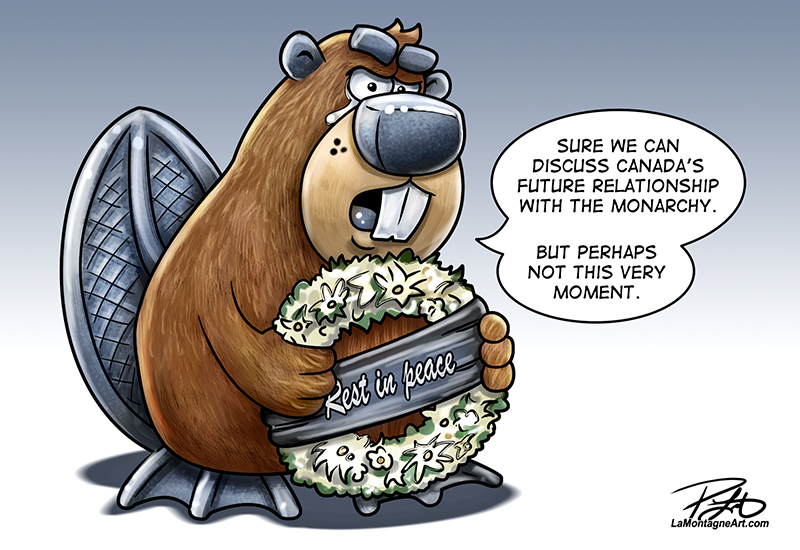 Canadians will no doubt have a necessary conversation in the coming weeks about this country’s relationship with the monarchy and how it will look in the future. But I drew this second cartoon last week reminding readers that it would be crass to dig into that before her interment. I’m not a monarchist, but one need not be to understand simple respect for the recently deceased and empathy for her family and those who grieve her passing.
Canadians will no doubt have a necessary conversation in the coming weeks about this country’s relationship with the monarchy and how it will look in the future. But I drew this second cartoon last week reminding readers that it would be crass to dig into that before her interment. I’m not a monarchist, but one need not be to understand simple respect for the recently deceased and empathy for her family and those who grieve her passing.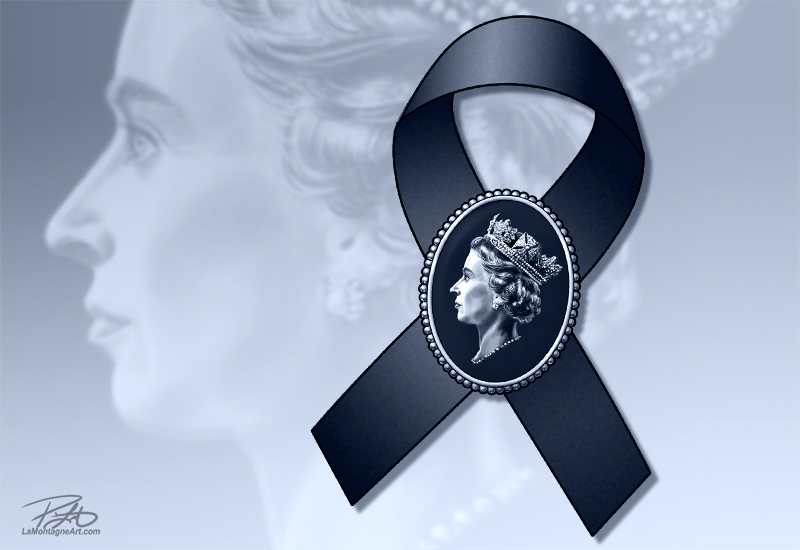 While I don’t enjoy or look forward to drawing them, these types of editorial cartoons are still part of the job.
While I don’t enjoy or look forward to drawing them, these types of editorial cartoons are still part of the job.

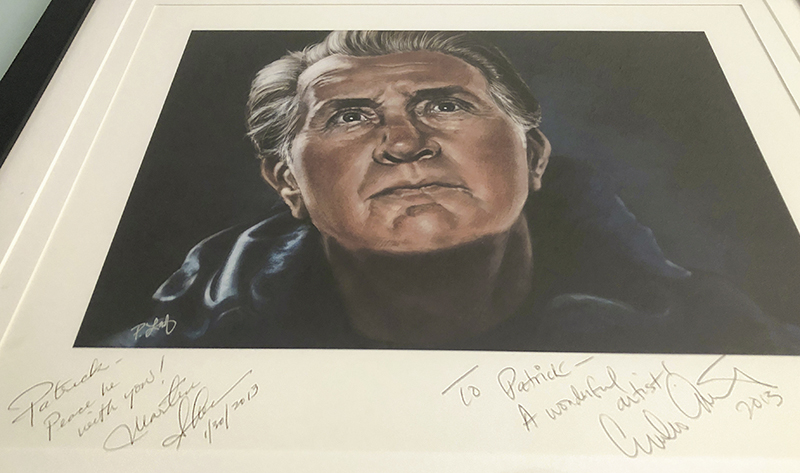 Another was when I painted Canadian astronaut Chris Hadfield while he was in command of the International Space Station. He saw
Another was when I painted Canadian astronaut Chris Hadfield while he was in command of the International Space Station. He saw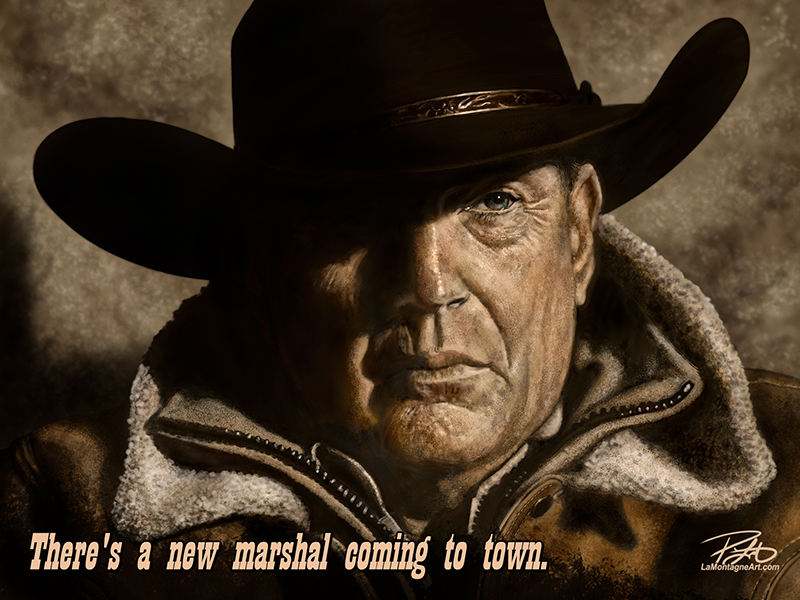 As it also made national news, and Yellowstone is a wildly popular show, I sent it out to my other papers this morning, in case there’s more interest in it. For context outside of Calgary, I added “Calgary Stampede:” before the caption for those other papers.
As it also made national news, and Yellowstone is a wildly popular show, I sent it out to my other papers this morning, in case there’s more interest in it. For context outside of Calgary, I added “Calgary Stampede:” before the caption for those other papers.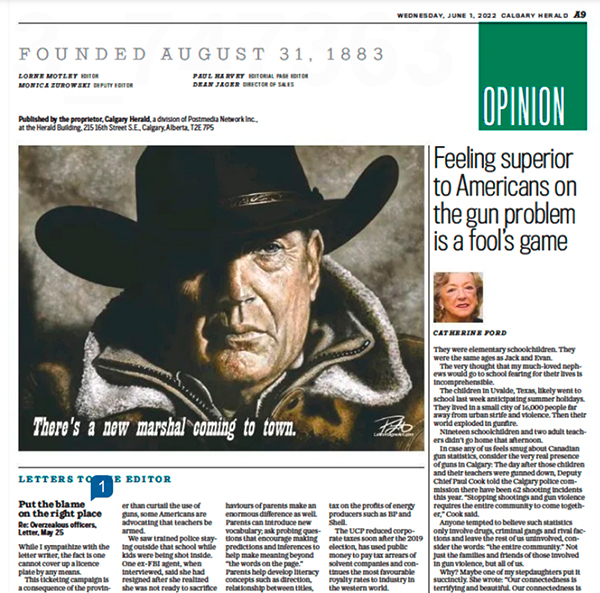 The Costner portrait file is 30” X 40” with a lot of detailed brushwork. To shrink it down and prepare it for newsprint, I had to boost the contrast, oversharpen it, and make other Photoshop adjustments to mitigate a poor result. So while I was happy to see it printed in the Calgary Herald (digital edition above), I couldn’t help but see all the flaws in the reproduction, even though I know that most people won’t notice or care.
The Costner portrait file is 30” X 40” with a lot of detailed brushwork. To shrink it down and prepare it for newsprint, I had to boost the contrast, oversharpen it, and make other Photoshop adjustments to mitigate a poor result. So while I was happy to see it printed in the Calgary Herald (digital edition above), I couldn’t help but see all the flaws in the reproduction, even though I know that most people won’t notice or care.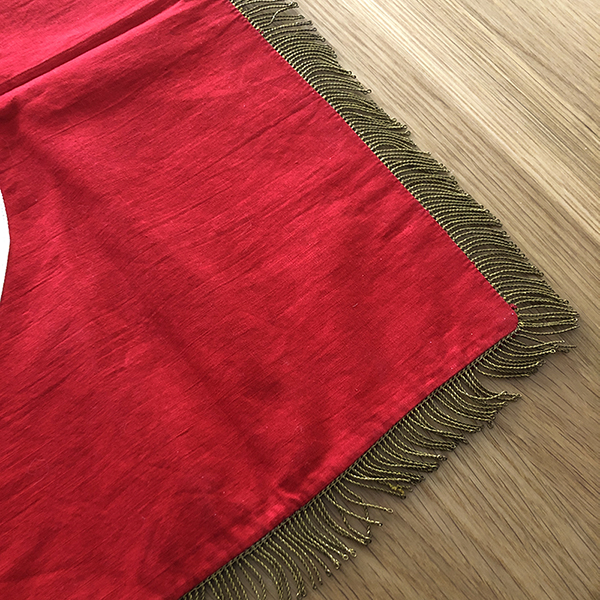

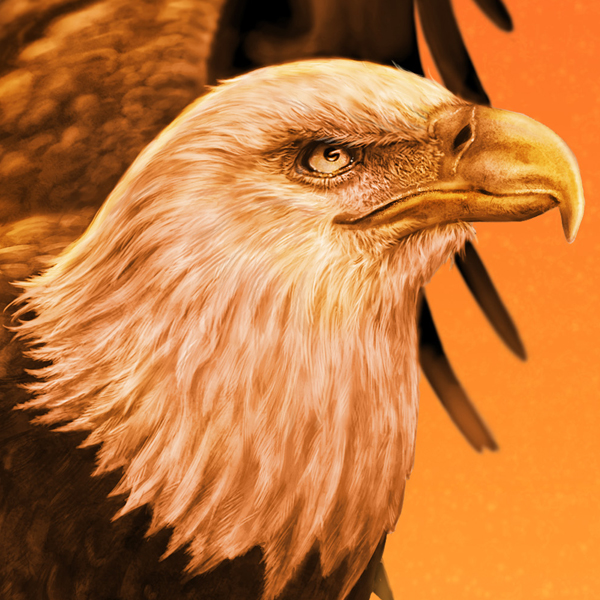
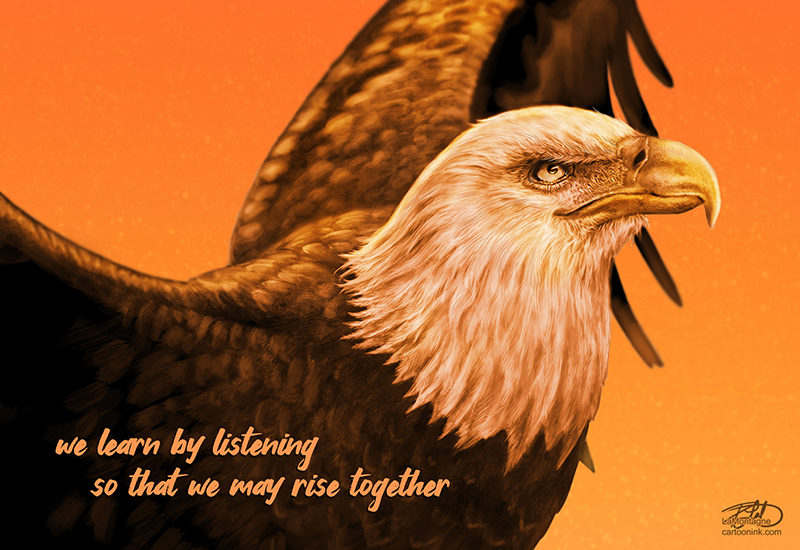 Early in this editorial cartoon profession, somebody once told me that editorial cartoons are supposed to make you laugh, think, and hopefully do both. I think it was Terry Mosher (Aislin).
Early in this editorial cartoon profession, somebody once told me that editorial cartoons are supposed to make you laugh, think, and hopefully do both. I think it was Terry Mosher (Aislin).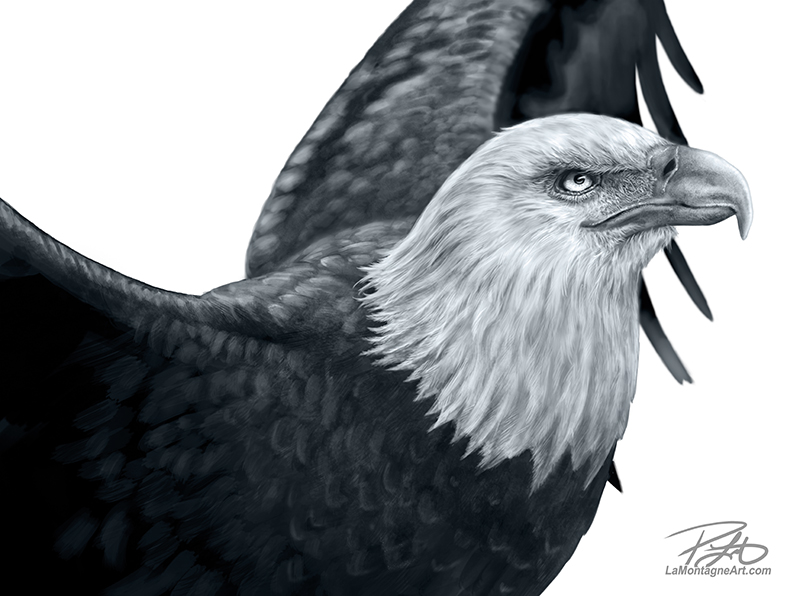 When I first created my animal art, I called them Totems but stopped the practice a few years ago.
When I first created my animal art, I called them Totems but stopped the practice a few years ago.